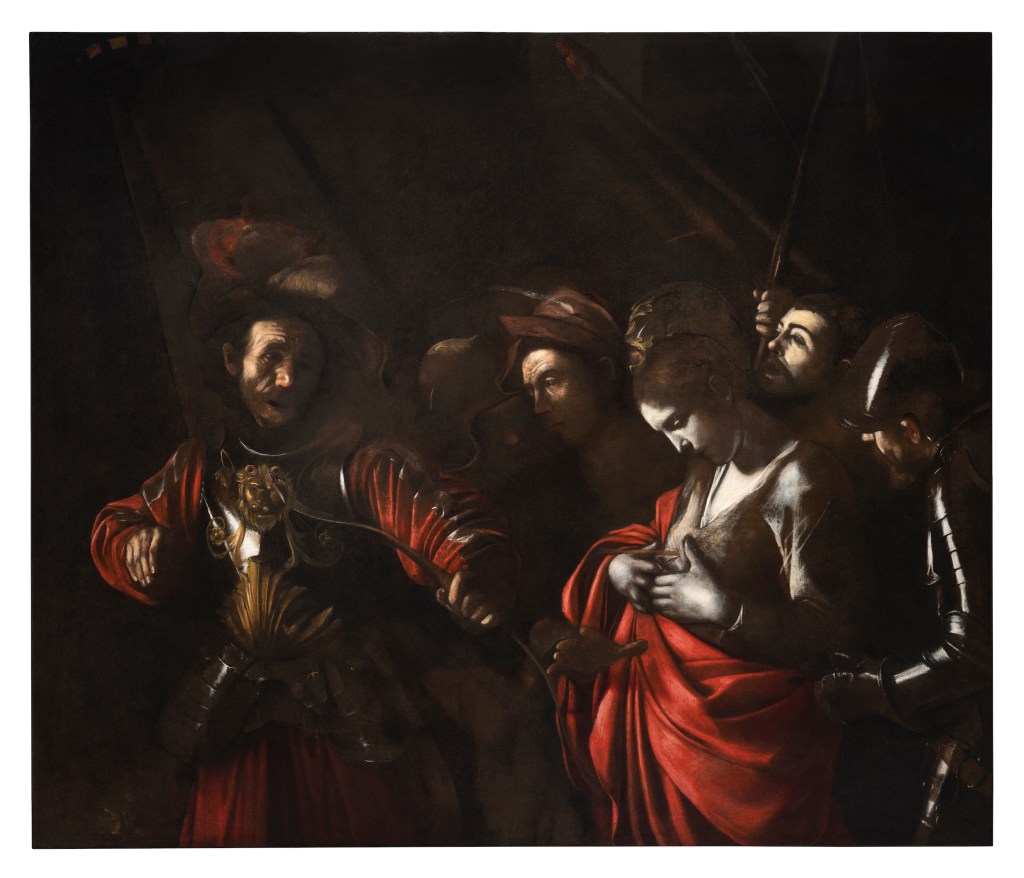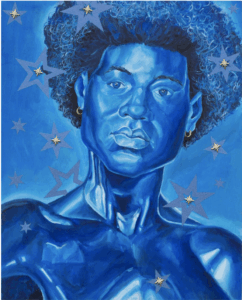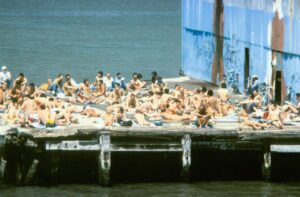The Intense Intimacy of Caravaggio


ROME — The exhibition Caravaggio 2025 at Palazzo Barberini, one of the two seats of the Galleria Nazionale di Roma, is particularly personal. I say “particularly” because Caravaggio’s art has the ability to draw his audience in, to create what feels like an intensely intimate experience for each viewer. His paintings all share certain characteristics. First, his work is always close to the picture plane. His subjects’ elbows seem to stick out of the canvas, one leg of a stool seems to teeter on the frame, a basket of fruit almost protrudes from the surface. Second, after his early phase as an independent artist — arriving in Rome in 1595, in utter poverty, and beginning from nothing — he liked to paint his subjects against a plain black or brown background, with minimal detail, further pushing the action toward the viewer. Third, he obsessively copied reality, almost never creating figures wholly from his imagination, and he never made preparatory drawings. Not a single drawing by Caravaggio exists. He was a thoroughly material painter, avoiding anything ideal even when treating subjects with divine or otherworldly meaning. He seems to speak to us directly and clearly, indeed photographically, given his love of striking light and shadow. We experience him personally.
All this and more made him stand out from the crowd of artists in late 16th-century Rome who vaunted drawing and composition over naturalism. He was the most famous painter in Europe in his lifetime, but his violent life and early death damaged his posthumous reputation. After being forgotten, or even reviled, for centuries, he was re-evaluated in the 20th century and emerged as the most famous European Old Master of the 21st, which encouraged an explosion of research into his life and art. The result is this exhibition, an extraordinary gathering of 24 of his works in Palazzo Barberini. A 25th, his only painted ceiling, is in the Casino dell’Aurora Ludovisi, also in Rome. Normally closed to the public, the owners have consented to open the building for this exhibition on the weekends.

The show, curated by Francesca Cappelletti, Thomas Clement Salomon, and Maria Cristina Terzaghi, is one of those pitch-black affairs with spotlights on the pictures, a style I detest as it creates pools of glaring reflected light on the canvases. The space is also inadequate, cramming the artworks into four rooms and cramming the visitors in around them. Moreover, there is no clear reason for the exhibition, if not to announce the arrival of the new director of the Galleria Nazionale, Thomas Clement Salomon, with an easy blockbuster, and the inclusion in the Caravaggio canon of several works of less than certain authorship, most notably the “Narcissus” and the early portrait of Maffeo Barberini.
But the pictures themselves are a parade of marvels. Caravaggio’s early career is amply represented in the first section, and amazing loans abound, from the “Boy Peeling Fruit” (1592–93) from Hampton Court in the United Kingdom to “The Cardsharps” (c. 1595, Kimbell Art Museum, Texas), “The Musicians” (1597, Metropolitan Museum of Art), and the dazzlingly confident “Saint Catherine of Alexandria” (c. 1598–99, Museo Nacional Thyssen-Bornemisza, Madrid), which is on the cover of the catalog. Against a dramatic black background, a young woman stares out at us guardedly, posed next to the broken spiked wheel that was meant to torture her, and holding the sword that would martyr her. The palm of martyrdom lies across the red damask cushion. Without these symbols she would simply be what she is, a beautiful young woman, perhaps the Sienese courtesan Fillide Melandroni, in contemporary clothes. She often posed for Caravaggio; her face recurs again and again in this exhibition.

The second section focuses on portraits. Maffeo Barberini, the builder of Palazzo Barberini and future pope Urban VIII, appears in two works, painted within only four years of each other but so utterly different that I can hardly recognize them as the same man. If the earlier portrait, still only an attribution, is a striking assemblage of well-observed details, the later one is a fully adult masterpiece in which Barberini reaches out a commanding finger with a self-assurance that is matched by the artist.
The Jubilee year of 1600 was a watershed for Caravaggio — he received his first major public commission, the Contarelli chapel in San Luigi dei Francesi, so the chapel would be ready for pilgrims. From that point on his career was guaranteed. For the next six years he would rise and rise in success, painting the two side pictures in the Cerasi chapel in Santa Maria del Popolo and the altarpiece of the Madonna of Loreto for the Cavalletti Chapel in Sant’Agostino, all to public acclaim. The first version of the “Conversion of St. Paul” (1600), painted on a huge cedar panel for the Cerasi chapel, and now in the Odescalchi Collection in Rome, is on view in the third section, which charts the artist’s rise and terrible fall, occurring after he murdered his opponent following a game of tennis and had to flee Rome for Naples. In this section we can see the National Gallery of Ireland’s “The Taking of Christ” (1602), surely one of Caravaggio’s most beautiful pictures, traced through diligent archival research by co-curator Francesca Cappelletti, and the newly discovered (2021), “Ecce Homo” (c. 1605–9) from the Prado in Madrid, which doesn’t quite convince me. Also here is his most moving painting, “David with the Head of Goliath” (1606–7 or 1609–10), in which the head of Goliath is a self-portrait of the artist as a sinner repenting too late. It was a clear response to his crime, and a plea for forgiveness. The huge, breathtaking “The Flagellation of Christ” (1607), loaned from the Museo Nazionale di Capodimonte in Naples, is captivating with its torsion of Christ’s body.
The final painting in the last section, and possibly Caravaggio’s last work, is “The Martyrdom of Saint Ursula” (1610), in which the blacks are absolute and the whites are ghostly. In the end, the shadings faded away, the colors intensified, and everything sank into the darkness. “Death and Nature, Michele,” wrote the poet Giovanni Battista Marino of Caravaggio in 1619, nine years after the artist’s premature death, “made a cruel plot to harm thee.” This exhibition makes him live again.






Caravaggio 2025 continues at the Galleria Nazionale di Palazzo Barberini (Via delle Quattro Fontane, 13, Rome, Italy) through July 6. The exhibition was curated by Francesca Cappelletti, Maria Cristina Terzaghi, and Thomas Clement Salomon.






